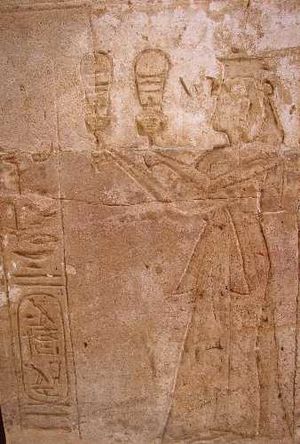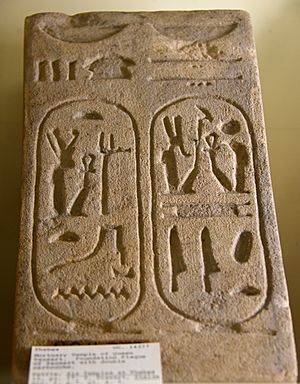Twosret facts for kids
Quick facts for kids Twosret |
|
|---|---|
| Tausret, Tawosret | |

Twosret playing the sistrum at Amada Temple, Nubia
|
|
| Pharaoh | |
| Reign | 1191–1189 BC (19th Dynasty) |
| Predecessor | Siptah |
| Successor | Setnakhte |
| Consort | Seti II (?) |
| Children | KV56 mummy (?) |
| Father | Merneptah (uncertain) |
| Mother | Takhat (uncertain) |
| Died | 1189 BC |
| Burial | KV14 in the Valley of the Kings |
| Monuments | Mortuary temple in Western Thebes |
Twosret, also known as Tawosret or Tausret, was an important female ruler in ancient Egypt. She was the very last pharaoh of the Nineteenth Dynasty of Egypt. She ruled around 1191 to 1189 BC.
Historians believe she ruled Egypt for about seven years. However, this included the time her stepson, Siptah, was pharaoh. Twosret took over his years as her own. Her own rule as pharaoh lasted for about two to three years. Her royal name, Sitre Meryamun, means "Daughter of Re, beloved of Amun."
Contents
Family Life
We don't know exactly when Twosret was born. Many historians think she was the daughter of Merneptah, a powerful pharaoh. Her mother might have been a woman named Takhat. This would make her the sister of Amenmesse.
Queen and Wife
Twosret was likely the second main wife of Seti II, who was also a pharaoh. It's not clear if Twosret and Seti II had any children together. Some people think a mummy found in a tomb called KV56 might be their daughter.
A famous archaeologist, Theodore Davis, found jewelry belonging to Twosret and Seti II in tomb KV56. This tomb also had items from Ramesses II. There are different ideas about what this tomb was for. Some think it was for a daughter of Seti II and Twosret. Others believe it was a collection of items from Twosret's own tomb.
Becoming a Regent
After her husband Seti II died, Twosret became a regent. A regent is someone who rules for a young king who is not old enough to rule alone. She ruled alongside a powerful official named Chancellor Bay. The young king was Siptah, who was probably Twosret's stepson. His mother was likely a woman named Sutailja or Shoteraja.
Ruling as Pharaoh
When Siptah died, Twosret officially became the pharaoh of Egypt. She took on the full title of a pharaoh, calling herself the "Daughter of Re, Lady of Ta-merit, Twosret of Mut."
It was once thought that she ruled with Chancellor Bay's help. However, a discovery showed that Bay was actually executed (killed) by Siptah's orders during Siptah's fifth year as king. This means Bay was not helping Twosret when she became pharaoh. A piece of pottery, called an ostracon, was found that announced this news to the workers. It said:
"Year 5 III Shemu the 27th. On this day, the scribe of the tomb Paser came announcing 'Pharaoh, life, prosperity, and health!, has killed the great enemy Bay'."
This message meant that all work on Bay's tomb had to stop. He was now seen as a traitor to Egypt.
During this time, some Egyptian lands in a region called Canaan might have become independent. They were possibly controlled by a man named Irsu. Some ancient writings suggest that Irsu and Twosret might have worked together. This allowed Irsu to take things from the land and not take care of it.
End of Twosret's Rule
Twosret's rule ended in a difficult time for Egypt. There was a civil war, which is like a fight within the country. This is mentioned in a stone carving by the next pharaoh, Setnakhte. Setnakhte started a new family of rulers, the Twentieth Dynasty.
We don't know if Setnakhte removed Twosret from power or if she died peacefully. If she died peacefully, then different groups at court might have fought for the throne, and Setnakhte won. Setnakhte and his son, Ramesses III, later described the end of the 19th Dynasty as a time of great confusion.
Setnakhte took over Twosret's tomb, KV14, which she shared with Seti II. He moved Seti II's body to another tomb, KV15. Setnakhte also covered up all images of Twosret in tomb KV14 and replaced them with his own. This shows that he likely did not like Twosret.
Later, Ramesses III, Setnakhte's son, removed Twosret and Siptah from the official list of Egyptian kings. This made it seem like they were not true pharaohs. It seems very likely that Setnakhte took power from Twosret in a civil war.
The latest known date for Twosret's rule is from her eighth year as pharaoh. This was found on a building block from her temple. Her temple was mostly built, but not fully decorated. This suggests she ruled for several more months after this date, possibly even starting a ninth year, before Setnakhte took over.
Buildings and Writings
It is believed that during Twosret's time, people traveled to mines in Sinai and Palestine to get turquoise. Statues of her have been found in important cities like Heliopolis and Thebes. Her name also appears in other places across Egypt and Nubia.
Here are some places where Twosret's name or monuments have been found:
- The Bilgai Stela: This stone carving belonged to Twosret. It shows she built a monument in an area called Sebennytos.
- A statue: There is a statue of Twosret and Siptah together in a museum in Munich. Siptah is shown sitting on Twosret's lap.
- Amada Temple: In this temple, Twosret is shown as a "Great Royal Wife" and "God's Wife."
- Heliopolis statue: A statue from Heliopolis shows Twosret as a woman, but her names are written with both male and female titles.
- Qantir: A special oval shape with her name, called a cartouche, was found here.
- Mines: Twosret and Siptah's names were found at turquoise mines in Sinai and Palestine.
- Tell Deir Alla: A fancy vase with Twosret's cartouche was found in Jordan.
- Mortuary temple: Twosret started building a temple for her memory next to the Ramesseum. It was never finished, but recent digs show it was more complex than first thought.
Her Tomb
Twosret's tomb, KV14, is in the Valley of the Kings. It has a long and interesting history. It was first started during the rule of Seti II. Scenes in the tomb show Twosret with Siptah, but later Siptah's name was changed to Seti II's.
Then, Setnakhte took over the tomb. He made it much bigger, making it one of the deepest royal tombs. Twosret's stone coffin, called a sarcophagus, was taken and used by another person named Amenherkhepeshef in a different tomb, KV13. Some historians believe Seti II was first buried in a room in KV14 and later moved to KV15.
A mummy found in tomb KV35, known as Unknown Woman D, has been suggested by some to be Twosret. However, there is no strong proof for this idea, other than the mummy being from the correct time period.
See also
 In Spanish: Tausert para niños
In Spanish: Tausert para niños


